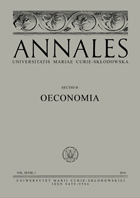Occurrence of Calendar Anomalies in Dividend Companies – the Case of Quarter-of-the-Year Effect
Occurrence of Calendar Anomalies in Dividend Companies – the Case of Quarter-of-the-Year Effect
Author(s): Aleksandra Pieloch-BabiarzSubject(s): Economy, Business Economy / Management, Financial Markets
Published by: Wydawnictwo Naukowe Uniwersytetu Marii Curie-Sklodowskiej
Keywords: seasonal anomalies; quarter-of-the-year effect; dividend companies; the Warsaw Stock Exchange
Summary/Abstract: Theoretical background: The efficient-market hypothesis (EMH) states that share prices immediately and fully reflect all information available on the market, so stock investors are not able to “beat the market” in the long term. Since stock exchanges are not fully efficient, there are numerous exceptions to EMH, called market anomalies (seasonal anomalies, fundamental anomalies, etc.). The occurrence of such anomalies enables stock investors to achieve excess market returns. Therefore, market anomalies are of particular interest to them. However, there are no studies on “beating the market” in the long term by dividend investing. Research to date has focused mainly on the short-term response of the capital market to dividend announcements.Purpose of the article: The purpose of this paper is to examine whether by dividend investing stock investor is able to “beat the market” on quarterly basis, i.e. achieve excess market returns in some quarters of the year. In order to conduct the research, the following hypothesis was formulated: The average rates of return on the dividend index are higher in the third quarter of the calendar year than the average rates of return on other indices.Research methods: The study was carried out in the period between 2012 and 2019 on the Warsaw Stock Exchange (WSE) using rates of return on income indices (i.e. WIG, WIGdiv, WIG20TR, WIG30TR, mWIG40TR and sWIG80TR). The main method used for the calculation was Kruskal–Wallis H test.Main findings: Average returns on examined indices were negative in the second quarter of the year. Our finding is consistent with the so-called holiday effect. The highest rates of return occurred in the third quarter, except for small and medium companies. In these cases, the highest returns were observed in the first quarter). The study conducted with the use of the Kruskal–Wallis H test showed that the null hypothesis, stating that the cases come from the same population, cannot be rejected.
Journal: Annales Universitatis Mariae Curie-Skłodowska, Sectio H Oeconomia
- Issue Year: LIV/2020
- Issue No: 4
- Page Range: 101-109
- Page Count: 9
- Language: English

